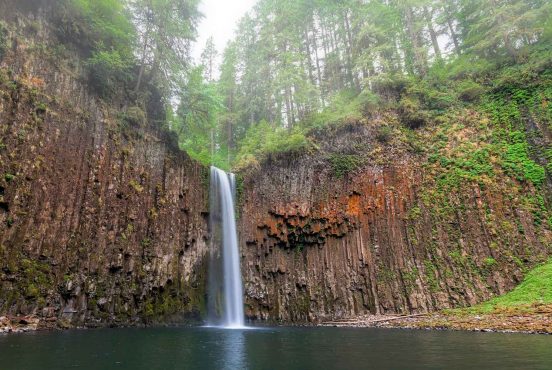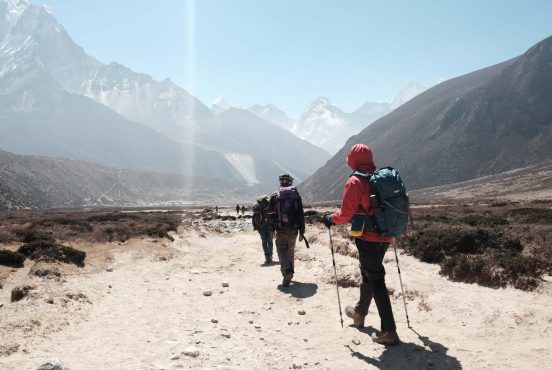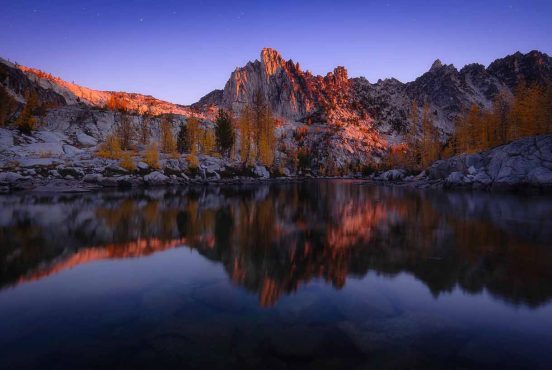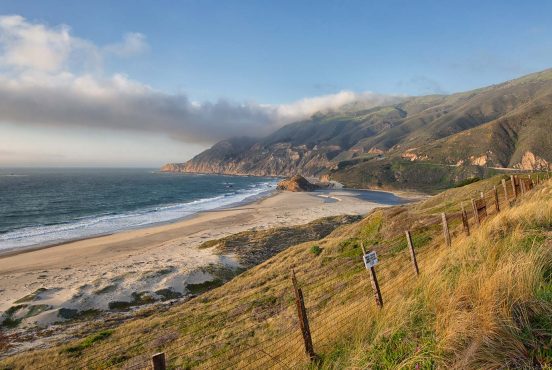From layers to lunch, here’s everything you need to know before tackling Colorado’s highest peaks.
My alarm blared at 2:30 am, tearing me from the comfort of my warm bed. By 4 am, I found myself at the base of Mount of the Holy Cross — one of the 54 Colorado peaks above 14,000 feet in elevation — with nothing but a headlamp illuminating the trail. The world was cloaked in darkness as I took sleepy steps forward on the singletrack. Hour after hour, mile after mile, we slowly covered over 11 miles and 5,600 feet of climbing in one day. The mountain challenged my mental strength and every muscle in my body.
Then finally, we were done. Standing on top of that peak, I was rewarded with jaw-dropping, 360-degree panoramic views that made every laborious step worth it. Jagged mountain ranges rippled into the distance, with unobstructed views as far as the eye could see. Breathing in the thin air, I couldn’t decide what took my breath away more: the altitude or the awe-inspiring beauty surrounding me.
There’s something undeniably humbling about standing on top of the world, feeling simultaneously invincible and incredibly small. It doesn’t matter if it’s one of the easiest 14ers or one of the toughest; each time I summit one of these giants, I remember why I keep returning. The climb is grueling, but the reward? Absolutely exhilarating. These are the moments that keep me coming back, again and again, to chase summits and sunrises.
But let’s be honest: tackling a giant like Mount of the Holy Cross in a day isn’t just about sheer willpower and a good pair of boots. Being prepared is half the battle. The right gear can mean the difference between an epic adventure and a miserable slog. Before you lace up and head out to conquer Colorado’s sky-scraping beauties, let’s talk essentials. We’ve compiled a packing list to ensure you’re prepared to soak in those summit views and enjoy the journey.

The Gear: What to Pack for a 14er Hike
The stakes are higher when you hike a 14er — literally and figuratively. I’ve tackled numerous 14ers over the years, and I can confidently say none come easy. The extreme temperature changes, unpredictable weather, demanding terrain, thin air, and long hours on the trail require a different level of grit and gear.
Layer Up
Colorado weather is like a box of chocolates; you never know what you’re gonna get. The key to staying comfortable is layering.
It can be downright frigid on top of a 14er. Temperatures drop about five degrees for every 1,000 feet you climb. A solid layering system allows you to easily add and shed layers, which you will do multiple times during the climb.
Start with a moisture-wicking merino wool baselayer to keep sweat off your skin. Skip the cotton; it’ll leave you cold and miserable. Add a light long-sleeve layer, a fleece mid-layer, and an insulated jacket. These layers will keep you warm without weighing you down. Down is lightweight, compressible, and warm, making it a no-brainer for warmth. Even after 20 years in Colorado, I still have an irrational fear of being cold (blame it on my California blood) and always pack more layers than I need.

I never go anywhere without rain gear (jacket and pants). Even if the weather is clear, there is always a chance of rain in Colorado. A waterproof jacket doubles as wind protection. Additionally, a beanie and gloves are two packable items that keep your extremities toasty.
Finally, don’t skimp on your socks and shoes. Thick wool hiking socks and sturdy, well-fitted boots are your best friends on a 14er. Blisters and sore feet are not the kind of trail companions you want. If there’s snow on the trail, consider gaiters to keep your feet dry and comfortable.
Nutrition and Hydration
Proper nutrition and hydration are not just important; they’re crucial for a successful 14er hike. I learned this the hard way. My hangry alter-ego — we call her Jean — emerges when my blood sugar drops after hours of exertion. Jean is not a fan of Type 2 fun and can be downright cranky. But give Jean a cookie, and everything changes.
To keep her at bay, I make a point to snack regularly, or about once an hour. Consistent calorie intake is key, whether it’s a few bites of energy chews, dried fruit, gummy bears, chocolate, or any of my other favorite hiking snacks. Remember, your body is your most important gear, so take care of it.
Once you reach the peak, the hard part isn’t over. Pack a more substantial lunch to refuel before the journey down. Aim for a mix of carbs, protein, and fat for a well-balanced meal that will slowly burn as you descend.
Water is a heavy but critical component of your pack. After summiting Mount of the Holy Cross, I realized I had just sucked down the last three liters of my water. Luckily, I sweet-talked some overnight campers into borrowing their water filtration system to refill my pack at a creek. A portable water filter like a LifeStraw is a game changer, ensuring you’ll never run dry.
Pro tip: Note where freshwater streams are because you’re unlikely to find them near the top.
Electrolytes have been my other secret weapon for wiping out Jean. Carrying a separate electrolyte-infused water bottle replenishes what your body loses while sweating. It helps keep my energy up on longer missions and prevents hydration.

Backpack
Choosing a well-fitting backpack is crucial for long hikes. Look for one with a waist strap to shift weight from your shoulders to your hips. For me, a 28L pack has been the perfect size for years. It’s spacious enough to hold extra layers for longer treks but can be cinched down for shorter jaunts.
Sun Protection
The sun is intense at altitude, so protect yourself with a hat and sunglasses. Or, if you have a sun shirt that you really like, that’s always a great option, too. Slather on the sunscreen before you hit the trail, and bring a small bottle to reapply. Nothing spoils a summit selfie like a sunburn.
Your Survival Kit
A map and compass are must-haves, even if you’re relying on GPS or a hiking app like AllTrails or Gaia. Electronics can fail, but your navigation skills shouldn’t. And always carry fire-starting tools: lighter, waterproof matches and a firestarter. A fire can be a lifesaver in an emergency, providing warmth and light, scaring away animals, and helping rescuers find you. It also provides a sense of peace and hope in the darkest hours.
A basic first aid kit should include bandages, moleskin, ibuprofen, and gauze. You never know when a blister or small cut might need tending. Also, don’t forget a headlamp with fresh batteries. A reliable light source is crucial whether you’re starting in the dark or taking longer than expected.
Hiking Poles
Trekking poles might not be essential, but they’re certainly helpful, especially on the descent. Find a pair that collapses and attaches to your pack when you’re not using them. Poles provide balance when crossing uneven and rocky terrain. They also take the strain off your knees and protect your joints. It took me years to start using hiking poles. I don’t carry them for daily hikes, but I’ve realized how much my body benefits from the extra support on longer and steeper treks.

Why are 14ers different from other hikes?
Altitude Adjustment
Even if you’re a mountain dweller like me at 8,000 feet in Vail, the air feels thin, and each step a little harder and heavier as you ascend in elevation. For those not accustomed to such heights, the altitude is more pronounced. Altitude sickness isn’t just a buzzkill; it can be downright dangerous. So, take your time, listen to your body, and don’t hesitate to slow down. Even the fittest among us need a snack break now and then.
Physically Challenging
14ers will push your limits. The steep ascents and the significant elevation gain mean your quads and calves are in for a workout. And just when you think you’ve conquered the most challenging part by reaching the summit, the descent will remind you that gravity can be a cruel companion, especially on your knees and thighs.
Additionally, the summits are covered in scree, or loose, rocky fields with large boulders that will test the balance and agility of even a seasoned hiker.

Severe Storms
Afternoon storms are a common occurrence in Colorado. When you’re 14,000 feet up, there’s no quick escape when you are above treeline.
I’ve had my fair share of close calls, which are downright scary.
I was enjoying a snack on the summit of Mount Elbert before noon when I could see storm clouds quickly gathering. It was time to beeline it down. Within minutes, we were hustling down the mountain, tripping through the scree fields and watching in disbelief as others continued to climb into the storm’s path. Don’t let your goals (or your ego) stand in the way of your safety. You should always aim to be off the summit no later than noon to allow time to descend safely.
Are you ready?
Tackling a 14er is no small feat, but the reward is worth every ounce of effort. So, lace up your boots, pack your gear, and get ready to conquer one of Colorado’s tallest peaks.
Seen in: Gear, Hikes, Hiking Gear











